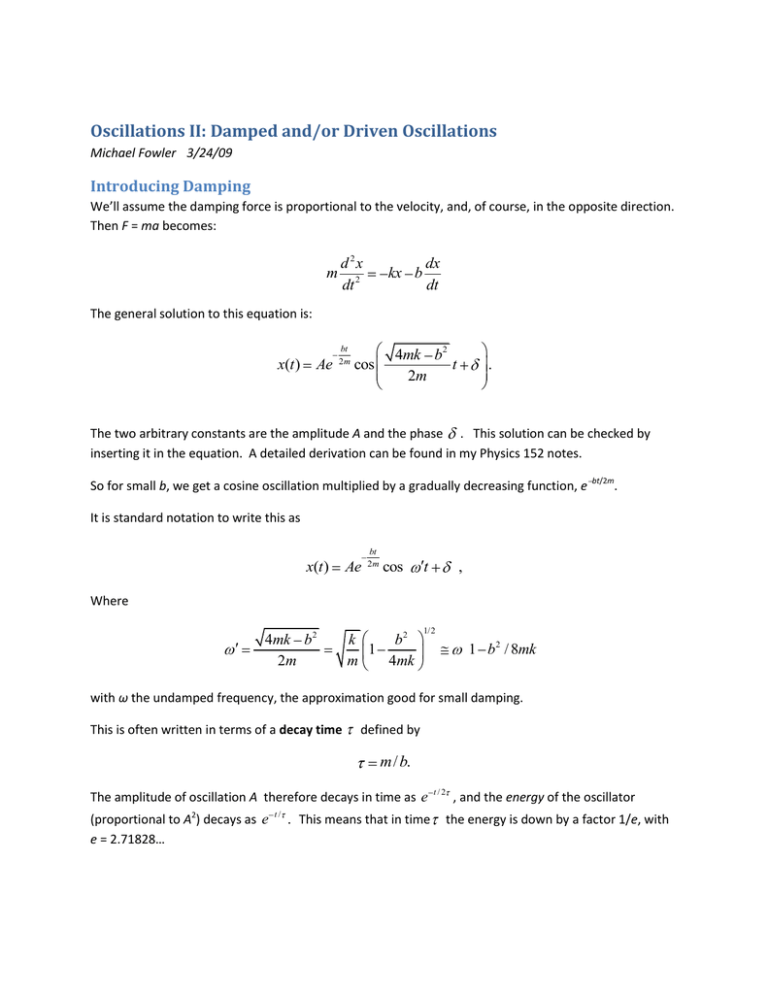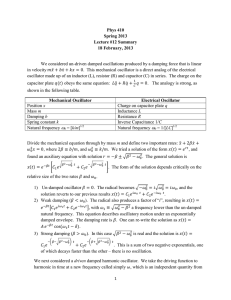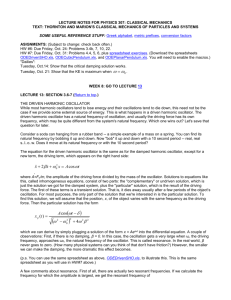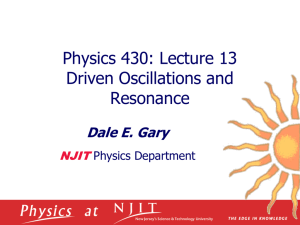Oscillations II: Damped and/or Driven Oscillations Introducing Damping
advertisement

Oscillations II: Damped and/or Driven Oscillations Michael Fowler 3/24/09 Introducing Damping We’ll assume the damping force is proportional to the velocity, and, of course, in the opposite direction. Then F = ma becomes: m d 2x dt 2 kx b dx dt The general solution to this equation is: x(t ) Ae bt 2m cos 4mk b2 t 2m . The two arbitrary constants are the amplitude A and the phase . This solution can be checked by inserting it in the equation. A detailed derivation can be found in my Physics 152 notes. So for small b, we get a cosine oscillation multiplied by a gradually decreasing function, e bt/2m . It is standard notation to write this as x(t ) Ae bt 2m cos t , Where 4mk b2 2m k b2 1 m 4mk 1/2 1 b2 / 8mk with ω the undamped frequency, the approximation good for small damping. This is often written in terms of a decay time defined by m / b. The amplitude of oscillation A therefore decays in time as e 2 (proportional to A ) decays as e e = 2.71828… t/ . This means that in time t/2 , and the energy of the oscillator the energy is down by a factor 1/e, with 2 The Q Factor The Q factor is a measure of the “quality” of an oscillator (such as a bell): how long will it keep ringing once you hit it? Essentially, it is a measure of how many oscillations take place during the time the energy decays by the factor of 1/e. Q is defined by: Q 0 so, strictly speaking, it measures how many radians the oscillator goes around in time . For a typical bell, would be a few seconds, if the note is middle C, 256 Hz, that’s 0 2 256, so Q would be of order a few thousand. Exercise: estimate Q for the following oscillator (and don’t forget the energy is proportional to the square of the amplitude): Damped Oscillator 1 0.5 0 0 10 20 30 40 50 60 -0.5 -1 The yellow curves in the graph above are the pair of functions +e bt/2m, e bt/2m, often referred to as the envelope of the oscillation curve, as they “envelope” it from above and below. Shock Absorbers and Critical Damping A shock absorber is basically a damped spring oscillator, the damping is from a piston moving in a cylinder filled with oil. Obviously, if the oil is very thin, there won’t be much damping, a pothole will cause your car to bounce up and down a few times, and shake you up. On the other hand, if the oil is really thick, or the piston too tight, the shock absorber will be too stiff—it won’t absorb the shock, and you will! So we need to tune the damping so that the car responds smoothly to a bump in the road, but doesn’t continue to bounce after the bump. Clearly, the “Damped Oscillator” graph in the Q-factor section above corresponds to too little damping for comfort from a shock absorber point of view, such an oscillator is said to be underdamped. The opposite case, overdamping, looks like this: 3 Overdamped Oscillator 1 0.5 0 0 5 10 15 20 25 30 -0.5 -1 The dividing line between overdamping and underdamping is called critical damping. Keeping everything constant except the damping force from the graph above, critical damping looks like: Critically Damped Oscillator 1 0.5 0 0 5 10 15 20 25 30 -0.5 -1 This corresponds to 0 in the equation for x(t) above, so it is a purely exponential curve. Notice that the oscillator moves more quickly to zero than in the overdamped (stiff oil) case. You might think that critical damping is the best solution for a shock absorber, but actually a little less damping might give a better ride: there would be a slight amount of bouncing, but a quicker response, like this: 4 Slightly Underdamped Oscillator 1 0.5 0 0 5 10 15 20 25 30 -0.5 -1 You can find out how your shock absorbers behave by pressing down one corner of the car and then letting go. If the car clearly bounces around, the damping is too little, and you need new shocks. A Driven Damped Oscillator: the Equation of Motion We are now ready to examine a very important case: the driven damped oscillator. By this, we mean a damped oscillator as analyzed above, but with a periodic external force driving it. If the driving force has the same period as the oscillator, the amplitude can increase, perhaps to disastrous proportions, as in the famous case of the Tacoma Narrows Bridge. The equation of motion for the driven damped oscillator is: m We shall be using d 2x dx b kx 2 dt dt F0 cos t. for the frequency of the driving force, and oscillator if the damping term is ignored, 0 for the natural frequency of the k / m. 0 Looking at this equation, suppose we try a solution x A cos t . We see won’t quite work, because there will be a sine term from dx/dt on the left hand side. But we can take care of that problem by using x A sin t A sin t cos A cos t sin , and feeding this into the left hand side of the equation we find that the sine terms will cancel if the phase φ is chosen correctly: that is, if tan m 2 0 2 / b . The amplitude of the driven oscillations is given by: F0 A m 2 2 2 2 0 . b 2 2 Before going on to examine this solution, what about the fact that a second order differential equation should have a solution with two adjustable parameters to fit any initial boundary condition? Suppose 5 we’d turned on the external force at t = 0? We can’t adjust φ, that’s fixed by the oscillator’s parameters, (including the damping strength). The key is that this so-called steady state solution isn’t quite the whole story: we could add to it any solution of the undriven equation, that is, of d 2x dx m 2 b kx 0, dt dt and we’d still have a good solution of the driven equation. Referring back to the undriven but damped oscillator, we can add x(t ) Be bt 2m cos t , 4mk b2 . 2m This has two arbitrary parameters, B and δ, so any initial condition can be met, and this term dies away exponentially, so, typically after a few oscillations, the system tends to the steady-state solution. It’s worth examining the magnitude of the oscillations for various driving frequencies: for very high frequencies, the amplitude dies away as A = F0/mω2, for weak damping the response is most dramatic at the natural frequency: for ω = ω0, A = F0/bω.





